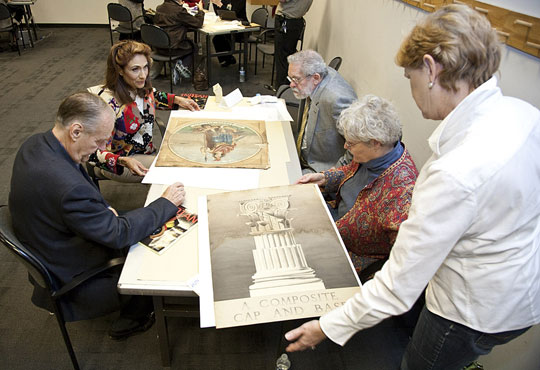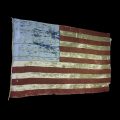From the Secretary: The institutional memory of archives
The Smithsonian proudly embraces a tradition of preserving history and bringing it to life for new generations. Nothing is more illustrative of that ethos than the archival collections from our museums, galleries and research facilities. This immense repository includes over 115,000 cubic feet of archival material, which if laid out end to end in boxes, would extend for nearly 19 miles—about the length of 180 Washington monuments! It is one of the largest—one might even say, most monumental—collections of historical document resources in the United States.

The Smithsonian Institution Archives’ Public Reference Room in Washington, D.C. (Photo by Ken Rahaim)
Records and audio recordings, letters, diaries, scrapbooks, maps and moving image media—they all inhabit the chambers of the Smithsonian, helping to tell the stories behind the artifacts, as well as their own stories. The Smithsonian Institution Archives document our own rich history, and the Archives’ newly-redesigned website provides online access to those records and advice from the expert Archives staff.

The photograph from the 1950s shows a time when air travel was glamorous and exciting. (Photo by Rudy Arnold 1902-1966) AIR TRANSPORT, AIRLINES, USA from Rudy Arnold Photo, National Air and Space Museum Archives.
Meanwhile, the National Air and Space Museum’s Archives, rapidly expanding thanks in part to NASM’s relationship with NASA, is moving to its new facility at the Udvar-Hazy Center. NASM currently holds 14,000 cubic feet of documents detailing the spectacular evolution of the design and technology of flight. The Archives of American Art is the world’s largest archival visual arts resource center, also holding about 14,000 cubic feet of papers and primary records available for researchers. These collections typify the diversity and extent of the remarkable archives available at the Smithsonian, and soon the public will get to sample some of them in person.
All’s Fair

Smithsonian Institution Archives’ Paper Conservator Nora Lockshin speaks with members of the public about their archival items during the “Ask the Smithsonian” event at the 2010 Smithsonian Archives Fair. (Photo by Michael Barnes)
October is American Archives Month, and to celebrate we are presenting our second Annual Archives Fair on Friday, Oct.14 in the Dillon Ripley Center. Our specialists will discuss how they collect, preserve and increase access to archival material, as well as inviting questions from the public. Our Ask the Smithsonian program, which was such a hit last year, will again show people how they can care for the important items or documents in their own homes, from photographic preservation to electronic archiving. Additionally, we have assembled a series of lecturers who will share their best practices with other archivists, highlight collections and discuss preservation techniques. You can find out more about the fair here, with photo galleries, oral histories, and a behind-the-scenes blog from previous participants.
Collectors of Content and Seekers of Context

Portrait of a Masai man created by Kermit Roosevelt or Edmund Heller, 1909. From a hand-painted lantern slide documenting the Smithsonian-Roosevelt African Expedition of 1909. Repository: Smithsonian Institution Archives
Archives play many important roles for our mission of learning and preservation. They provide evidence of what has happened in the past and put events and people in context, which helps us understand our own time and culture. Archives help us choose future collections and open new lines of inquiry, new avenues of research, and new mysteries that lie at the heart of discovery and learning.
Of course, it’s not simply the archives that are vital to our mission. The Smithsonian’s Archives staff includes a dedicated corps of full-time employees, volunteers and interns. All of the people who catalog, care for, and contextualize these treasure troves of historical data are invaluable in making our Archives ever more accessible. For a Society of American Archivists contest to create an “elevator speech” to explain what archivists do, winning contestant Lisa Lewis eloquently noted, “Archivists bring the past to the present. They’re records collectors and protectors, keepers of memory.” One way in which they have continued to keep those memories is through the rapidly changing tools of the digital age.
Technological Advances

The Smithsonian Institution Archives’ Collection Vault of Historic Photography with John Dillaber, Staff Digital Imaging Specialist. (Photo by Ken Rahaim)
Throughout the Smithsonian, we have been actively seeking to leverage new, powerful instruments of technology. It isn’t hyperbole to say that the latest technologies have revolutionized archives as we know them. No longer simply the province of researchers, the archives of the Smithsonian are now open to students and teachers, amateurs and professionals, and learning enthusiasts everywhere. Users can now easily search the Smithsonian’s archival resources within the Collections Search Center and the online SIRIS catalog.
Social media like Youtube, Facebook, Flickr and Twitter have allowed us to connect with and engage the public in ways unimaginable a decade ago, but more is to come. People will increasingly be able to use augmented reality to marry their own archival information“stories, photos, links”with existing exhibitions, giving visitors a greater sense of ownership over content.

Smithsonian Secretary Leonard Carmichael at the National Zoological Park with a baby gorilla, Leonard (left), and chimpanzee (right), 1961, Smithsonian Institution Archives, Historic Images of the Smithsonian
These tools have also made it possible for archivists to connect with one another, conduct research more quickly, and rapidly digitize items. The Archives of American Art, with funding from the Terra Foundation for American Art, has led the way. By using the latest automation, archivists can store massive amounts of archival material online. As a result, visitors to the Archives for American Art’s website can now view more than 1.5 million digital files online, a number that only hints at the eventual magnitude of the Smithsonian’s digital archives.
Looking Back, Looking Ahead
Lincoln, in his first inaugural address, identified “The mystic chords of memory” as the harmony that would hold the Union together through the discord of war. He was right, and a shared memory still resonates and binds us as a nation. Archives allow us to look back on our past and hold onto memories, collectively and individually. These recorded memories are as varied as they are insightful: A wartime note from President Lincoln to a Union general scrawled on an envelope at the American History Museum; slides of Yoruba art at the National Museum of African Art;the Smithsonian’s first attempts in 1846 to document North American Indian cultures, displayed at the National Anthropological Archives and Human Studies Film Archives; the papers of linguist Lorenzo Dow Turner at the Anacostia Community Museum Archives phonetically transcribe a woman’s native Creole-based Gullah language, recalling her experience during the 1886 South Carolina earthquake.
We all have our own tangible memories. Pictures of great-grandparents, love letters from our youth, baseball cards tucked away in a drawer. Embedded in all are stories waiting to be discovered and shared. Nowhere is this better done than through our archives“from the slides and photos at the Smithsonian American Art Museum, to archival art materials at the Freer and Sackler Galleries, to cultural archives at the National Museum of the American Indian and the Center for Folklife and Cultural Heritage and Collections.
At the Smithsonian we are fortunate to have a wealth of archives upon which to draw, and a dedicated and talented group of archivists to help tell our defining stories. I urge you to take in this year’s Archives Fair and experience for yourself the Smithsonian’s “keepers of memory.”

Smithsonian experts speak with members of the public about their archival items during the “Ask the Smithsonian” event at the 2010 Smithsonian Archives Fair. (Photo by Michael Barnes)
Posted: 3 October 2011
- Categories:










The Institution has MANY individual archival units representing a diverse scope of our nation’s cultural, arts, native, and scientific heritage. Please check out A Guide to the Archival Resources at the Smithsonian Institution at
http://sirismm.si.edu/siris/SIASC/index.htm.
gostei muito das infomações contida na materia. queria saber mais sobre a instituição.
(Editor’s note: This comment translates as “I really like the information contained in this material. It makes me want to learn more about the Institution.”)